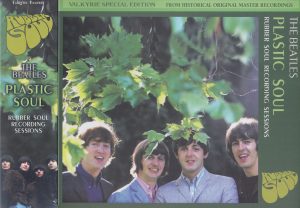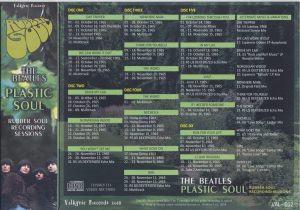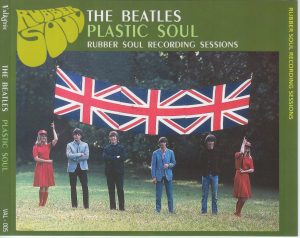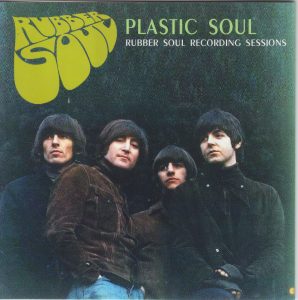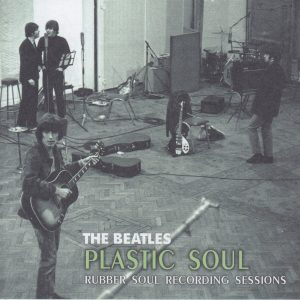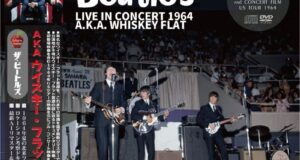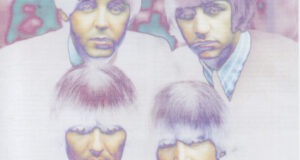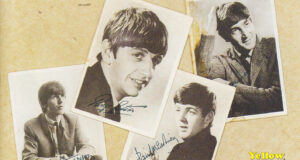Beatles / Plastic Soul / 6CD Wx Slipcase / Valkyrie
Translated Text:
Plastic Soul & Rubber Soul Recording Sessions. Digitally Remastered
Click Image To Enlarge
■ Ultimate set including many first appearance sound sources that have never been recorded anywhere.
■ It is longer than the previous episode, including those that are recorded for the first time in an unedited manner.
The Beatles, which was already locally famous in local Liverpool before his debut, swept the UK and Europe in 1963 since his debut in 1962. As soon as 1964 opened, he recorded the number one in the US with “I want to hug” In a short period of time it quickly became a global star. Meanwhile, I was busy with a lot of TV and radio appearances as a promotion as well as live performances in parallel. In the first rice in February 1964, only two performances of the live and Ed Sullivan show appeared to fuel the hunger of the fans, full of summer tours in the US. In the meantime, I also have movie shoots, and I wonder where the album had time to produce.
The Beatles ‘album also reflected the Oldies’ influence at first. Perhaps if the Beatles had broken up in “For Sale”, it would have been recognized as a posterity Oldies band. After “Help”, artistic gradually became more highly evaluated than idle and it reaches the present. In the early days, John ‘s talent bloomed quickly, and in’ Hard Days Night ‘John’ s charm was full of John ‘ And later that Paul began to bloom her talent later than “Help”. Not to mention “Sargent Peppers” and “Abbey Road”, Paul was the musical initiative in the late Beatles. John and Paul antagonized for the first time in “rubber soul” in that transition period, and in “revolver” it is an album in which John and Paul were completely reversed. It can be said that the flowering time of talent has revealed that the Beatles has long reigned as a top runner throughout the 1960s, that John changed from early to middle and Paul slightly shifted from middle to late, leading to the evaluation of future generations.
In this way, the sixth Beatles album “Rubber Soul” is said to be a masterpiece of the era when John and Paul talented each other. Release was December 1965. After the second American tour, it was an album that was made in just over a month to make it in time for the Christmas shopping season. However, such a briskness is an album that does not felt dust and gives a very calm and moist impression. More noteworthy is that this album is not an old rock and roll. It seems that beautiful songs are lined up enough to inform you that the Beatles are not just a rock band and that Brian Wilson is also shocked by listening to this album, a very highly artistic completion It boasts degrees. This work contains the recording session of “Rubber Soul”.
【Day · Tripper】
The beginning of this work is not an album record, but two songs that were recorded in the same session at the same time and released as a single. “Day Tripper” was played in the 1966 tour and familiarity with the less performing ambition of the Japanese performance is deep. John and Paul take a twin vocal with impressive vocals using chorus work, guitar riff and falsetto. In the Beatles of this period when the two are the main singing style to sing the songs each composed, it is unusual to sing with the two who reminiscent of the beginning. It was released on both sides in the UK in the coupling with “Let’s hold a love” below, but it was treated as B side in Japan and the United States. Disk 1 Track 1 is take 1. That guitar riff is played from Paul’s count. In contrast to the stable drums of apples, the riff of the guitar is somewhat unstable yet. Truck 2 Take 2 was played after the announcement. Instant playing did not begin, and the Beatles’ members talked aloud somehow. Immediately interrupt the performance and shift to take 3. This take 3 is supposed to be a momentous and wonderful performance, which may have been extensively reviewed beforehand. It is still a simple take that does not contain guitar, drums, bass, vocals and simple performances and tambourines of break parts. Vocals are also single tracks and fresh. Truck 4 re-records the guitar, and vocals are another rough take. Truck 5 finally adds tambourine and the outline of the song is clear. Vocal is also another rough alternative. The vocal becomes double track from the track 7 and the thickness increases. In addition, it seems that it was decided that the part of the interlude that was not completed in the previous take was composed of a guitar and a chorus.
【Hold Your Love in Hell] “Dei Tripper -” and a single song released on both sides A, in the United States this alone released as the A side, this number is also the number 1 in the United States. It is a catchy song that Paul’s talent was demonstrated to its fullest. On stage it is being played on the UK tour of winter 1965, but unfortunately there are no recordings left. Because I did not shoot so much at the stage or because it was difficult to play on the stage, I get out of the set list the following year. Paul frequently played this song since becoming a solo, and started playing as an acoustic number in the tour, including unplugged in 1991. Disk 1 Tracks 16 and 17 are a demonstration sound source which is played by Paul’s acoustic guitar. Although it is a very simple performance, the charm of a song can already be known. Although the origin of this sound source is unknown, probably Paul recorded it myself when there was time. The session began on October 20th. Track 18 is take 1. There is John ‘s misunderstanding and begins with Paul’ s count. It is a very early version that just plays the chord to match the drum, it is a recording that left extremely to the left. In track 2, Paul’s single vocals are superimposed. There is no Harmonium which determines the impression of the song, and it gets a very refreshing impression. Harmonium is superimposed on track 22, finally close to the final version. Vocal is another take. I felt that my song was not good, I re-recorded the vocal again on October 29th. That is after track 23. Furthermore, on track 24, it is processed to double track, and you can listen to vocals with two poles. The chorus part of John and George is mixed on the front, and it is understood that this is for confirming the vocal and the chorus.
【Drive My Car】
Decorating the first song of the A side of the Beatles album is always a song with impact. Not to mention “Please Please · Me,” which starts with a high count, “With the Beatles”, suddenly begins with vocals, “For Sale” “Help”, and “Hard Days Night”. “Rubber Soul” is selected as “Drive My Car” which starts normally as a matter of course. This song was recorded on October 13, 1965. Disk 2 Track 1 is a basic track starting from the count of poles. If you listen to this you can see how well the rhythm was conscious of the soulful performance that emphasized. As the main is based on the bass part of the guitar which is about the same phrase as the baseline, I succeeded in creating a very grave rhythm. While it is a basic track, I hear that pole is speaking only at the part of chorus in the part of bitbeebie ye. The main vocal is Paul, John sings only part of the rust. But Paul’s live since becoming a solo is all through Paul singing.
【Norwegian Wood】
This song is indispensable for talking about the Beatles. In addition to the acoustic guitar, it was the first song to introduce sitar. Of course George is playing. The lyrics were singing something John secretly secretly hiding in Cynthia and singing in love with the lyrics “We talked until two and then she said” It’s time for bed “(We talked till late at night, After she said “It’s about time in bed”), it is configured to have long interludes. Indeed, it seems that this interlude part represents John and cheating partner’s affair. Returning the story back to the song, as John is always like this, the process of completing songs over and over with elaborate recordings is recorded in this work. Take 1 recorded on October 12, 1965 is a relaxed and uncomfortable tempo compared to the final version, with sitar being more emphasized arrangement. The name of the song is still announced in the tentative title “THIS BIRD HAS FLOWN”. Disk 2 Track 10 is still something John is playing and playing with Akogi before the sitar is overlapped yet, vocals are also single track. When this becomes the truck 11, sitar joins and the “burning smell” comes up with the impression of the song. Vocals are double tracks. Akogi, if anything, is a moderate mix with a sitar on the front. On track 12, not only is Akogi and Sitar mixed in the same amount, but the biggest change is that it plays the tempo with great care. It finally feels like it has approached the final version.
The date has changed and Take 2 is recorded on October 21st. Even at this point still the title is called “THIS BIRD HAS FLOWN”. John’s vivid single vocals are a great take for disc 2 track 16. Sitar is the main thing to match the rhythm picking by the apple back. It is followed by Take 3, but there is no recording left at the beginning here. I think that it would have been with an enthusiasm for completing on this day, and it is starting with take 4 more. As expected it seemed that sitar was over-emphasized too much, as in the final version, sitar remained at the level of seasoning and the main became acoustic. It is recorded that the intro is resuming after John failed twice.
[You Want to See Me] It is a flowing song with impressive cutting piano and cutting guitar that is exactly John Lennon. Hammond organ is joining, this is the performance of Rohdei’s Mal Evans. Paul plays this song on a solo tour twice in 2004 and 2017. In 2004, it was reproduced on the stage in a form close to complete copying, but in 2017 it was due to Akogi. The disk 2 track 24 is take 2. Vocal is not yet in it and it is a basic track. Unfortunately there is another mix for this song, but another take is currently unearthed and everything is included in this work.【That alone’s boy】
It is a song that is very impressive for Japanese fans as it is also performed in the Japanese performances and becoming a single. John, Paul, and George are choruses for six people because they are overlapping choruses in double tracks. Disk 3 Track 1 is take 5. It is a basic track and no vocals. The performance is still quite inconvenient. Track 2 is the first vocal insertion. Although singing quite carefully, it is obviously a different take vocal. Great. John sometimes makes places and sings places. You can see that the style of vocals and choruses is nearly complete. Track 3 is another vocal again. Better than the first vocal / take, it is impressive that John is singing to fit relatively other two people. John ‘s vocals in the chorus part will be made to be relieved where it comes out quickly. Also in the final version, when entering the lyrics part from the interlude, there is a high guitar sound of Kahn, but here we have not entered yet. There is no way to know what process was added, but if you do not have that, you will not be shut down yet, it is an accent that makes you feel good.
【A liar woman】
Here George’s vocal song finally appears. It can be said that George’s unique undulating songs. Paul still used Höfner at the stage, but he is already using Ricken at the recording. But since this song uses the base through fuzz, there is a feature in the bass sound. Disk 3 Track 9 is take 1 of “Think For Yourself”. There is no vocal and it is a basic track. Beginning with the count of George, the performance is not felt yet. Track 10 is a very interesting content. Whether it’s a studio or not, it is the atmosphere that the tape happened to have happened by members while practicing “Think For Yourself” while taking a break. The interactions of the lively Beatles in the studio are recorded, and the fan is nosebleed buzz. There are no other examples in which the inside of the studio remains relatively long like this. This is a conversation between members of the Beatles of nature, singing humming songs, deliberately telling a rude voice, making fun of other members. John takes the initiative and repeatedly repeats the chorus part of “Think For Yourself” whether it does not go well. Beyond the Beatles, George Martin’s voice is heard. Anyhow it’s fun playing in the studio and funny. Indeed, the Beatles’ studio memorizes even when it thinks that work was progressed with this appearance. Two types of George’s single vocals are recorded on tracks 13 and 14, respectively, and these two are mixed down to complete the final version.
【words of love】
The title is called “The Word”. It is a confusing subject matter whether those who named this title that “For sale” has a cover song called “Words Of Love” knew it. A wonderful masterpiece full of sprints. Recording is taking place on November 10, 1965. John’s guitar suffers according to the bouncing intro’s piano, and the chorus work is clear. And in the chorus part John pops out of the chorus of the chorus and takes a solo vocal. It is a perfect Beatles-style song reminiscent of the early days. Disc 3 The track 20 is a relaxed tempo outtake. Vocal also takes another take. The part of the rust is in an unfinished state and not yet inserted.
【Michelle】
It is a song that creates a quiet and calm adult atmosphere that is unlikely to be a rock band. It is the only song that the Beatles sang with lyrics other than English. This French was written after being supervised by her because his wife, Liverpool’s friend Ivan Vaughn, was a Frenchman. French translation of almost English poetry. As a result, this song is always irregularly sung in Paul’s French performance regardless of age. Also when I played in the 2010 White House, President Obama ‘s wife is still named Michelle, I am laughing, “I wish for the president to forgive”. First recorded disc 4 Tracks 1 and 2 are recordings of a draft rather than a demonstration of the same song. Track 1 is recorded in 1963, and although you can hear the phrase like that, it is still time consuming to be in the form of a song. Truck 2 was recorded in 1965, which is quite close to “Michelle”, but the finally cut phrases were scattered and interesting as an early initial version. Subsequently, track 5 is take 1. Paul is almost singing in a cappella in accordance with the rhythm that moves monotonically. The tempo is a little earlier. Paul is singing lively, there is no such melancholy atmosphere, no chorus is included, this is also an early version. Take 2 is another vocal again. Here Paul’s voice is mixed quite a lot. It is slightly echoed, it is part of trial and error.
【Lost Love】
I move from here to the album B side. A song in which three names were credited with only “Lennon McCartney = Star Key” which was recorded by tacit understanding that each album includes George and apple songs one by one. The idea of this song is old, John is said to be in his teens, but Paul added the middle part and completed it. It’s like a process like “Free As A Bird”. That is evidence, Disc 4 Track 17 is a demonstration sound source John vocalist recorded in 1963. Although the song is obviously “What Goes On”, there is a middle part not in the final version, and it is interesting as it is a short sample source for auction exhibition. Take 1 on track 18 is a basic track starting with John’s count. Trucks 19 and 20 are each recorded double vocals individually.
【Girl】
At the beginning the album “Rubber Soul” wrote that John and Paul’s talent are antagonistic, but this song and “In My Life” will represent the expression of John’s talent. It is an idea that effectively introduced breathing, it is a famous melody, good romantic and impeccable masterpiece impeccable. John ‘s solo album “Double Fantasy” released in 1980 contains the song “Woman”. In an interview John says “It is a 1980 edition girl.” Indeed the parts that are similarly used in the chorus part are used very similarly. Disc 4 The track 24 is only the announcement and the sound that plucks the guitar. Take 2 from track 25 is the monitor mix. The melody will follow properly while only riffs to engrave. Track 28 is a baroque guitar phrase that adds a noble atmosphere to songs.
【You go to the club】
It is a session of ‘I’ m Looking Through You ‘famous even for’ Sessions’ known for the existence of numerous outtakes from long ago. Take 1 creates a song atmosphere by undulating the melody according to a monotonous rhythm. Paul’s settled vocals, which can not be dispelled quite incomplete impression, will inform you that this is a demonstration sound source. Paul is playing this song even at the solo concert. All outtakes of this song, such as Abbey Road Shaw, John Barrett, Sessions, Anthology, etc in 1983 are based on this take 1. It is interesting that the ending becomes a hatchachan and John is making noise with a stupid voice. Take 4 of track 8 is redoing the intros twice. Just like an intermediate between take 1 and final version.
【In My Life】
This is not only a masterpiece by John, but also one of the songs that represent the Beatles. It is adopted in the opening scene in anthology in relation to lyrics. The Beatles era did not play at the stage, but George was playing with a big change in arrangement on the national tour of 1974. It is established as a song of John, but Paul argues that that is his song, John is misunderstanding. In any case, it is definitely an important masterpiece for the Beatles. Recording took place on October 18th. Disk 5 Track 16 is take 3. The vocal tracks are pointing to the right because the track on the left is open for dubbing. The interlude is incomplete and shed lightly on the guitar.
This song is part of the “Kimo” of “In My Life” along with the idea recorded earlier with George Martin’s high evaluation of that interlude, which is not normal speed. On the recording on October 22, the date changed, the interlude that was not completed yet has been undertaken. The piano solo which is quite different from the one adopted for the track 17 is very interesting is inserted. It is based on an organ such as Prokol Harum and does not go out of the field of studies, but it can be said that it is the day when the direction to do interlude by keyboard, not guitar. Track 18 is an interlude study by piano. In addition, the track 19 doubled the speed of the piano and finished like a harpsichord tone.
【weight】
It is a song that is not so popular as a topic, and it is a song different in “Rubber Soul”. Actually it was prepared for the album “Help”, it was a song that became a moment. “Rubber Soul” was the last day of the recording and it means that the songs are missing, because there was not enough time to make new songs to make it in time for the Christmas shopping season, it is a song that has recovered suddenly. Disk 5 Track 25 is take 4, but this is all this recording June 17, 1965. The Beatles decides to complete the song by duplicating this recording based on the record. In the track 26, vocals are played, in the track 27, the guitar is adjusted by stepping on the pedal, and in the track 28, the tambourine and maracas are dubbed to alleviate discordance with other songs with different recording times.
【If I Love You】
One of the representative songs of George of the Beatles era which was performed also in 1991 Japanese performances as the only George vocal song which was sung in the Budokan performance in 1966. Brilliant melodies in a gleaming guitar tone and light tempo have an atmosphere that seems to hit anything. At that time it was not released as a single from the power relationship within the band, but Hollies covered it and was single-cut instead. George said that he was dissatisfied with sales as a result of a crushing defeat. Recording took place on October 18th. The first recorded disc 5 track 31 is a basic track starting with take 1, George’s count. This song has not been excavated outtake, here multitrack, vocals, tamparin etc are recorded.
【Cheating girl】
To decorate the end of the album is always a grand opening round of songs, but at the end of “Rubber Soul” is John’s “Run For Your Life” of “bashing work”. John himself also did not appreciate this song so much, he also said he was planning to sing George in the beginning. As an element to smash bizarre work, I can hear the lyrics from Elvis’ “Baby Let’s Play House” as it is borrowed. Disk 6 Take 1 is take 1. However, the performance is not included, only the announcement of George Martin and the sound of the guitar before the performance. Take 2 for take 5. John ‘s vocal deeply echoed is a single track, with no chorus and a vigorous solo by John. Track 5 is the state of the Beatles being recorded. John instructs each member about the performance
■今までどこにも収録された事のない数多くの初登場音源を含む究極のセット。
■既発より長く、今回初めて未編集で収録されるものを含む。
デビュー前に既に地元リバプールで局地的に有名だったビートルズは、1962年のデビュー以来、1963年で英国と欧州を席捲、1964年が開けてすぐに「抱きしめたい」で全米ナンバー1を記録、わずかな期間で瞬くまに世界的スターとなっていった。その間プロモーションを兼ねて夥しい数のテレビやラジオ出演をこなし、平行してライブも行なうなど多忙を極めていた。1964年2月の初渡米はわずか2度のライブとエドサリバンショウの出演のみでファンの飢餓感を煽り、満を持して夏に全米ツアーを行なっている。さらにその間には映画撮影もあり、一体どこにアルバムを製作する時間があったのだろうかと思うくらいである。
ビートルズのアルバムも最初はオールディーズの影響を色濃く反映したものであった。おそらくビートルズが『フォーセール』で解散していたら、後世オールディーズのバンドとして認識されていたであろう。それが『ヘルプ』以降、徐々にアイドル性よりも芸術性の方が高く評価されるようになり現在に至る。初期はジョンの才能がいち早く開花し、『ハード・デイズ・ナイト』ではジョンの魅力が溢れたジョンの独壇場ともいうべき名盤となっている。そして遅れてポールが才能を開花させ始めたのが『ヘルプ』以降であろう。『サージェントペパーズ』や『アビーロード』は言うに及ばず、後期のビートルズはポールが音楽的な主導権を握っていた。その過渡期において『ラバーソウル』で初めてジョンとポールが拮抗し、『リボルバー』においては完全にジョンとポールが逆転したアルバムとなっている。このように才能の開花時期が、ジョンが初期から中期、ポールが中期から後期と、微妙にずれたことが、ビートルズが60年代を通して長くトップランナーとして君臨させ、後世の評価に繋がっていると言える。
このように、ビートルズ6枚目のアルバムである『ラバーソウル』は、ジョンとポールという二人の才能がそれぞれ拮抗した時代の名盤であるといえる。リリースは1965年12月。2度目のアメリカン・ツアー後、クリスマス商戦に間に合わせるため、わずか1カ月あまりで製作されたアルバムである。しかしそのような慌ただしさは微塵も感じられず、非常に落ち着いたしっとりとした印象を与えてくれるアルバムである。さらに特筆すべきは、このアルバムが古いロックンロールではない、という点である。美しい楽曲が並ぶ様は、ビートルズが単なるロック・バンドではないという事を知らしめるに充分であり、ブライアン・ウィルソンがこのアルバムを聴いてショックを受けたというのも頷ける、非常に芸術性の高い完成度を誇っている。本作は、この『ラバーソウル』のレコーディング・セッションを収録したものである。
【デイ・トリッパー】
本作の冒頭を飾るのはアルバム収録曲ではないが、同時期に同じセッションで収録されシングルとしてリリースされた2曲である。「Day Tripper」は1966年ツアーで演奏され、日本公演のあまり覇気のない演奏が馴染みが深い。コーラス・ワークとギター・リフ、ファルセットを駆使したボーカルが印象的なジョンとポールがツインボーカルを採る曲である。それぞれが作曲した曲を歌うスタイルになり、二人がメインというのは少なくなっていくこの時期のビートルズにおいて、初期を彷彿させる二人で歌う珍しいものとなっている。後述の「恋を抱きしめよう」とカップリングで英国では両A面でリリースされたが、日米ではB面扱いであった。ディスク1トラック1はテイク1である。ポールのカウントからあのギターリフが奏でられる。リンゴの安定したドラムスとは対照的にギターのリフはまだどことなく不安定なものである。トラック2テイク2はアナウンス後もバタバタしていたのかすぐに演奏が始まらず、ビートルズのメンバーが何やら話し合う声が聞こえる。すぐに演奏は中断してテイク3に移行する。事前に随分と推敲が重ねられたのであろう、このテイク3は勢いある素晴らしい演奏になっている。まだギター、ドラム、ベース、ボーカルとシンプルな演奏でブレイク部分のタンバリンなどが入っていない簡素なテイクである。ボーカルもシングル・トラックで生々しいもの。トラック4はギターを録り直し、さらにボーカルもラフな別テイクである。トラック5でようやくタンバリンが加えられ曲の輪郭が明確になっている。ボーカルはこれもまたラフな別テイク。トラック7からボーカルがダブル・トラックになり厚みが増すことになる。さらにそれまでのテイクでは未完成だった間奏の部分がギターとコーラスで構成されることが決められたようだ。
【恋を抱きしめよう】
「デイ・トリッパ―」と両A面でリリースされたシングル曲で、アメリカではこちらが単独でA面としてリリース、全米ナンバー1もこの曲である。ポールの才能が存分に発揮されたキャッチ―な楽曲である。ステージでは1965年冬のUKツアーで演奏されているが、残念ながら録音は残っていない。あまりステージ映えしなかったのか、あるいはステージでの演奏が困難だったからか、翌年にはセットリストから外れてしまう。ポールはソロになってから頻繁にこの曲を演奏しており、1991年のアンプラグドを始め、ツアーにおいてアコースティック・ナンバーとして演奏している。ディスク1トラック16と17はポールひとりのアコギによる弾き語りデモ音源である。非常にシンプルな演奏ではあるが曲が持つ魅力は既に伺い知ることが出来る。この音源の出所は不明ながら、おそらくポールがひとり時間のある時に自分で録音したのであろう。セッションは10月20日から始まった。トラック18はテイク1である。ジョンの呟きがありポールのカウントで始まる。ドラムに合わせてコードを奏でるだけの極初期バージョンで、極端に左に寄った録音である。トラック2はポールのシングル・ボーカルが重ねられている。曲の印象を決定づけるハーモニウムが入っておらず、非常に爽やかな印象を受ける。それがトラック22ではハーモニウムが重ねられ、ようやく最終バージョンに近くなる。ボーカルは別テイクである。自分の歌がいまいちだと感じたのか、10月29日に再度ボーカルを録音し直している。それがトラック23以降である。さらにトラック24ではダブル・トラックに加工され、ポールが二人いるボーカルを聴くことが出来る。ジョンとジョージのコーラス部分が前面にミックスされており、これがボーカルとコーラスを確認するためのものだというのがわかる。
【ドライヴ・マイ・カー】
ビートルズのアルバムのA面1曲目を飾るのは、常にインパクトのある楽曲が選ばれている。高らかなカウントで始まる『プリーズ・プリーズ・ミー』、いきなりボーカルで始まる『ウィズ・ザ・ビートルズ』『フォーセール』『ヘルプ』、そして『ハード・デイズ・ナイト』は言うまでもなかろう。それらに比して『ラバーソウル』は至って普通に始まる「ドライブ・マイ・カー」が選ばれている。この曲は1965年10月13日に録音された。ディスク2トラック1はポールのカウントから始まるベーシック・トラックである。これを聴けばいかにリズムが強調されたソウルフルな演奏を意識したかがよくわかる。ベースをメインに、ベースラインとほぼ同じフレーズをギターの低音部分でなぞっているため、非常に重々しいリズムを作り出すことに成功している。ベーシック・トラックながらサビの部分でビッビービッビーイェーの部分のみポールが発声しているのが聞こえる。ボーカルはメインはポールで、サビの部分のみジョンが歌っている。しかしソロになってからのポールのライブでは全て通してポールが歌っている。
【ノルウェーの森】
ビートルズを語る上で欠かせないのがこの曲である。アコースティック・ギターに加え、シタールを導入した初めての楽曲となった。もちろん演奏しているのはジョージである。歌詞はジョンがシンシアに隠してこっそり浮気をしている様子を歌ったもので、歌詞で「We talked until two and then she said “It’s time for bed”」(俺たちは深夜2時まで語り明かし、その後彼女が言った「そろそろベッドの時間よ」)の後に、長い間奏が入る構成になっている。なるほど、この間奏部分がジョンと浮気相手の情事を表しているのであろう。話を曲に戻すと、ジョンは常にそうであるように、何度も推敲を重ね曲を完成させていく過程が本作に記録されている。1965年10月12日に収録されたテイク1は、最終バージョンと比べゆったりとした気怠いテンポで、シタールがより強調されたアレンジとなっている。曲名はまだ仮題『THIS BIRD HAS FLOWN』でアナウンスがなされている。ディスク2トラック10はまだシタールが重ねられる前のジョンがアコギで弾き語りをしているもので、ボーカルもシングル・トラックである。これがトラック11になるとシタールが加わり曲の印象にがらりと“焼香臭”がしてくる。ボーカルはダブル・トラックになっている。どちらかといえばアコギは控え目でシタールを前面に出したミックスとなっている。トラック12ではアコギとシタールが同じくらいのミックスがなされているのみならず、最大の変化はテンポを思いきり上げて演奏している点にある。ようやく最終バージョンに近付いてきた感じがする。
日付が変わり10月21日にはテイク2がレコーディングされている。この時点でもまだタイトルは『THIS BIRD HAS FLOWN』とコールされている。ディスク2トラック16はジョンの生々しいシングル・ボーカルが素晴らしいテイクである。バックはリンゴによる簡単なリズム採りに合わせ、シタールがメインのものとなっている。続いてテイク3であるが、こちらは冒頭しか録音が残されていない。この日に完成させる意気込みで臨んだのであろう、さらにテイク4にとりかかっている。さすがにシタールを強調し過ぎたと思ったのか、最終バージョンと同様にシタールは味付け程度に留まっておりメインはアコギになっている。イントロをジョンが2度失敗して再開している様子が収録されている。
【ユー・ウォント・シー・ミー】
軽快なピアノと、いかにもジョンレノンだというカッティング・ギターが印象的な流れるような曲である。ハモンド・オルガンが加わっているが、これはローディーのマルエバンスの演奏である。ポールは2004年と2017年の二度、ソロ・ツアーにおいてこの曲を演奏している。2004年は完コピに近い形でステージで再現されたが、2017年はアコギによるものであった。ディスク2トラック24はテイク2である。ボーカルはまだ入っておらずベーシック・トラックである。残念ながらこの曲は別ミックスは存在するが、別テイクは現在のところ発掘されておらず、本作に収録されているものが全てである。
【ひとりぼっちのあいつ】
日本公演でも演奏され、シングルにもなっているため非常に日本のファンにとって印象深い曲である。ジョンとポール、そしてジョージの3人がコーラスをダブル・トラックで重ねているため6人分のコーラスとなっている。ディスク3トラック1はテイク5である。ベーシックトラックでありボーカルは入っていない。演奏はまだ拙く心もとない。トラック2は初めてのボーカル入れである。かなり丁寧に歌っているが、明らかに別テイクのボーカルである。素晴らしい。ジョンは所々タメを作って歌っている。ボーカルとコーラスのスタイルはほぼ完成しているのがわかる。トラック3は、これもまた別ボーカルである。最初のボーカル・テイクよりおとなしめに、ジョンは比較的他の2人に合わせるように歌っているのが印象的である。サビの部分でジョンのボーカルがグッと前に出てくるところにハッとさせられる。また最終バージョンでは間奏から歌詞の部分に入る際、カーンという高いギター音が入っているが、ここではまだ入っていない。どのような過程で加えられたのか知る由もないが、あれがないと今一つ締まらず、センスの良さを感じさせるアクセントである。
【嘘つき女】
ここでやっとジョージのボーカル曲が登場する。起伏の少ないジョージならではの曲であるといえる。ポールはステージでは依然としてヘフナーを使用していたものの、レコーディングでは既にリッケンを使用している。しかしこの曲はファズを通したベースを使っているため、ベース音に特長がある。ディスク3トラック9は「Think For Yourself」のテイク1である。ボーカルは入っておらずベーシックトラックである。ジョージのカウントから始まり、演奏はまだこなれていない感じである。トラック10は非常に興味深い内容である。スタジオであろうが、正式なレコーディングではなく、メンバーが休憩中に「Think For Yourself」の練習をしているところを、たまたまテープが回っていたという雰囲気なのである。スタジオ内での生々しいビートルズのやり取りが収録されており、ファンには鼻血ブーものである。スタジオ内の様子がこのように比較的長く残っているのは他に例がない。鼻歌を歌ったり、頓狂な声をわざとあげてみたり、他のメンバーをからかったりと、自然体のビートルズのメンバー間の会話がこれである。上手くいかないのか、ジョンが率先して何度も「Think For Yourself」のコーラス部分を繰り返している。ビートルズ以外ではジョージ・マーティンの声も聞こえる。とにかくスタジオ内でふざけたり、おどけたりしているのも面白い。まさにビートルズのスタジオは、このような様子で作業が進められていったのだと思うと感動すら覚えてしまう。トラック13と14はジョージのシングル・ボーカルが2種類それぞれ収録されており、この2つをミックス・ダウンして最終バージョンが完成する。
【愛のことば】
原題を「The Word」という。『フォーセール』に「Words Of Love」というカバー曲があるのをこのタイトルを命名した方は知っていたのかどうか紛らわしい邦題である。疾走感あふるる素晴らしい名曲。レコーディングは1965年11月10日に行なわれている。跳ねるようなイントロのピアノに合わせジョンのギターが被り、コーラス・ワークが冴える。そしてサビの部分ではコーラスの混沌からジョンが飛び出してソロ・ボーカルを採る。初期を彷彿させる完璧なビートルズ・スタイルの曲である。ディスク3トラック20はゆったりとしたテンポのアウトテイクである。ボーカルも別テイク。サビの部分は未完成でまだ挿入されていない状態である。
【ミッシェル】
ロック・バンドらしからぬ静かで落ち着いた大人の雰囲気を醸す曲である。ビートルズが英語以外の歌詞で歌った唯一の曲である。このフランス語はリバプール時代の友人アイヴァン・ヴォーンの妻がフランス人であったため、彼女の監修を受けて作詞された。ほぼ英語詩のフランス語訳。そのためポールのフランス公演では年代を問わず必ずイレギュラーにこの曲が歌われている。また2010年ホワイトハウスで演奏した際には、オバマ大統領の妻がやはりミッシェルという名前なだけに、「大統領が許してくれることを願うよ」と笑いをとっている。最初に収録されているディスク4トラック1と2は同曲のデモというよりは草稿という趣の録音である。トラック1は1963年の録音とされ、それらしきフレーズは伺えるが、まだ曲の形になるのは時間を要するものである。トラック2は1965年の録音とされ、こちらはかなり「ミッシェル」に近いが、最終的にカットされたフレーズが散見され、超初期バージョンとして興味深い。続いてトラック5はテイク1である。単調に刻むリズムに合わせポールがほぼアカペラで歌っている。テンポはやや早めである。ポールは溌剌と歌っており、あの物憂げな雰囲気はまだなく、コーラスも入っていない、これもまた超初期バージョンである。テイク2もまた別ボーカル。こちらはポールの声がかなり大きくミックスされている。若干エコーがかかっており、試行錯誤の一端なのであろう。
【消えた恋】
ここからアルバムB面に移る。各アルバムにジョージとリンゴの曲を1曲づつという暗黙の了解により収録された、唯一の「レノン=マッカートニー=スターキー」と3人の名がクレジットされた曲。この曲の着想は古くジョンが10代の頃だというが、それにポールがミドル部分を加え完成させたもの。まるで「Free As A Bird」のような製作過程である。それが証拠に、ディスク4トラック17は1963年にレコーディングされたジョンがボーカルをとるデモ音源である。曲は明らかに「What Goes On」であるが、最終バージョンにはないミドル・パートがあり、オークション出品用の短いサンプル音源ながら興味深いものである。トラック18のテイク1はジョンのカウントで始まるベーシックトラック。トラック19と20はダブル・ボーカルのそれぞれを単独で収録したものである。
【ガール】
冒頭でアルバム『ラバーソウル』はジョンとポールの才能が拮抗していると書いたが、そのジョンの才能の発露を代表するのがこの曲と「イン・マイ・ライフ」であろう。息継ぎを効果的に導入したアイデアといい、メロディといい、非の打ちどころのないロマンチックで完成された名曲である。1980年リリースのジョンのソロ・アルバム『ダブル・ファンタジー』に「Woman」という曲が収録されている。ジョンはインタビューで「1980年版のガールである」と述べている。なるほどコーラス部分で同じような息継ぎが効果的に使用されている部分が酷似している。ディスク4トラック24はアナウンスとギターを爪弾く音のみである。トラック25からのテイク2はモニター・ミックスである。刻むリフのみながらきちんとメロディが追える。トラック28は曲に高貴な雰囲気を加味しているバロック風のギター・フレーズである。
【君はいずこへ】
古くから数多くのアウトテイクが存在することで知られる、『セッションズ』でも有名な「I’m Looking Through You」のセッションである。テイク1は単調なリズムに合わせてメロディに起伏をつけて曲の雰囲気を醸成している。かなり未完成な印象は払拭出来ないがポールの落ち着いたボーカルが、これがデモ音源であることを伺わせる。ポールはソロ・コンサートにおいてもこの曲を演奏している。1983年アビーロード・ショウやジョンバレット、セッションズ、アンソロジーなど、この曲のアウトテイクは全てこのテイク1が元となっている。エンディングはハチャメチャになりジョンが頓狂な声で騒いでいるのが面白い。トラック8のテイク4は二度イントロをやり直している。ちょうどテイク1と最終バージョンの中間のようなアレンジである。
【イン・マイ・ライフ】
これもまたジョンによる名曲であるのみならず、ビートルズを代表する曲のひとつ。歌詞に絡めてアンソロジーではオープニングのシーンで採用されている。ビートルズ時代はステージで演奏する事はなかったが、ジョージが1974年全米ツアーで、アレンジを大幅に変えて演奏している。ジョンの曲ということで定着しているが、ポールはあれが自分の曲で、ジョンは勘違いしていると主張している。いずれにしてもビートルズにとって重要な名曲であることに違いはない。レコーディングは10月18日に行なわれた。ディスク5トラック16はテイク3である。ボーカルトラックが右に寄っているのは左側のトラックをダビングのために空けてあるのであろう。間奏は未完成でギターで軽く流している。
この曲はジョージ・マーティンが担当したあの間奏の評価が高く、通常のスピードではなく2倍に早めて収録したアイデアと共に「In My Life」のキモの部分である。日付変わって10月22日のレコーディングではそれまで未完成だったその間奏に着手されている。トラック17は非常に面白い採用されたものとは全く異なるピアノソロが挿入されている。プロコルハルムのようなオルガンによるもので、習作の域を出ないが、間奏をギターではなく鍵盤で行なうという方向が決まった日だと言える。トラック18はピアノによる間奏の習作。さらにトラック19はピアノのスピードを倍に挙げてハープシコードのような音色に仕上がった。
【ウェイト】
地味であまり話題に挙がらない曲であり、『ラバーソウル』の中では異色の曲である。実はアルバム『ヘルプ』の為に用意された、その時はボツになった曲である。『ラバーソウル』にレコーディング最終日になって曲が足りないということになり、クリスマス商戦に間に合わせるため新しい曲を作る時間的余裕がなかったため、急遽復活した曲である。ディスク5トラック25はテイク4であるが、録音はこれだけ1965年6月17日である。ビートルズはこの録音をベースにダビングを重ねて曲を完成させることを決める。トラック26ではボーカル、トラック27ではペダルを踏んで調節するギター、そしてトラック28ではタンバリンとマラカスをダビングし、録音時期の異なる他の曲との違和を緩和している。
【恋をするなら】
1966年武道館公演で歌われた唯一のジョージのボーカル曲にして、1991年日本公演でも演奏されたビートルズ時代のジョージの代表曲のひとつ。煌びやかなギターの音色と軽やかなテンポに明るいメロディは、いかにもヒットしそうな雰囲気を持っている。当時はバンド内の力関係からシングルとしてリリースされなかったが、代わりにホリーズがカバーしてシングル・カットされている。セールス的には惨敗に終わりジョージは不満だったと言う。レコーディングは10月18日に行なわれた。まず最初に収録されているディスク5トラック31はテイク1、ジョージのカウントで始まるベーシックトラックである。この曲はアウトテイクが発掘されておらず、ここではマルチトラックから、ボーカル、タンパリンなどが収録されている。
【浮気娘】
アルバムの最後を飾るのは常に壮大な締めくくりの曲を配するのが一般的だが、『ラバーソウル』の最後はジョンいわく「やっつけ仕事」の「Run For Your Life」であった。ジョン自身もあまりこの曲を評価しておらず、当初ジョージに歌わせる予定であったとも述べている。やっつけ仕事を匂わせる要素としては、歌詞をエルヴィスの「Baby Let’s Play House」からそのまま借用している箇所からも伺える。ディスク6トラック1はテイク1。ただし演奏は含まれずジョージ・マーティンのアナウンスと演奏前のギターの音のみ。トラック2はテイク5。深くエコーがかけられたジョンのボーカルはシングルトラックで、コーラスは一切入っておらずジョンの生々しい独唱である。トラック5はレコーディング中のビートルズの様子である。ジョンが各メンバーに演奏に関する指示を出している。ジョンの「わかったか、ボーイズ?」に対し、ポールが変声で「了解だよジョニー」と答えているのが面白い。
【12-バー・オリジナル】
ラバーソウルのセッション時に収録されたインスト曲。ずっと未発表曲であったが、アンソロジーで初めて公開された。クレジットはLennon ? McCartney ? Harrison ? Starkeyと4人の連名になっている。当時ジョンはビートルズの未発表曲について「Some Lousy 12 Bar」という曲があるとラジオのインタビューで答えている。ディスク6トラック10は同曲のリハーサルである。奇妙なオルガンが前面に出ており、まるで違う曲のように聞こえる。トラック11のトラック1はきちんとアナウンスが入り演奏が始まるが、曲が始まってすぐジョンが「ごめん!ごめん!」とミスを謝って中断してしまう。そしてポールの高らかなカウントでテイク2が始まる。リズムに合わせてソロを次々に重ねていく曲構成は、およそビートルズとしてリリースするには不似合いな曲である。何らかの意図をもってレコーディングされたのであろうが、発表する前提ではなかったのだろう。
【ALTERNATE MIXES & WORLDWIDE VARIATIONS】
ビートルズのアルバムは時代が緩やかだったこともあり、世界各国によってミックス違いが数多く存在する事が知られている。このような世界各国盤のミックス違いを集めたのが最後のディスクになる。こうして並べて聴いてみると、同じ曲ながらこうまでも違うのかと驚かされることだろう。
【PLASTIC SOUL】
ビートルズを意識していたローリング・ストーンズは、ブルースからソウルに至るブラック・ミュージックに活路を見出していた。言うまでもなくストーンズのメンバーはホワイトである。世のブラックたちはストーンズの事を「プラスティック・ソウル」、つまりまがい物のブラック・ミュージックであると揶揄していた。アンソロジーでも「アイム・ダウン」の後にポールが「Plastic Soul」と呟いているのが収録されている。これがアルバム『ラバーソウル』の製作中の仮題としてメンバー間で認知されていた。さすがに他人を揶揄する差別的な言葉をタイトルにするには憚られ、ゴムの靴底とかけて『Rubber Soul』と題したのである。いわばビートルズの言葉遊びである。アルバム・カバーはロバート・フリーマンがジョンの自宅庭で撮影した写真が採用されている。その時撮影した写真をスライドにしてビートルズに見せたところ、たまたまスライドの機械が傾いて写真が歪んでしまった。その状態が面白いということで、写真をわざと歪ませてアルバム・ジャケットに使われたのである。その元の歪んでいない写真が本作ディスク5と6のジャケットに使用されているものである。本作は、この『ラバーソウル』のスタジオ・セッションを集大成したタイトルである。美しいピクチャー・ディスク仕様の永久保存がっちりプレス盤。
DISC ONE
【DAY TRIPPER】
October 16, 1965
01.Take 1
02. Take 2 (breakdown)
OVERDUBS
03. Take 3 w/ Vocal track #1
04. Take 3 Guitar riff re-make + Rough Vocal
05. Take 3 Tambourine SI and Rough Vocal
06. Vocal Track #2 with reverb
07. Take 3 Guitar SI & Double tracking vocals
08. Take 3 monitor mix
09. Take 3 unedited full mix
October 26, 1965
10. RS1 US
11. RS2 UK
October 29, 1965
12. RM1 (The Music of L&M Special)
13. RM2
November 10, 1966
14. RS Re-Make “A Collection of Oldies”
MULTITRACK
15. Take 3 Instrumental
【WE CAN WORK IT OUT】
September – October 1965
16. Demo source 1
17. Demo source 2
October 20, 1965
18. Take 1
19. Take 2 w/single vocal track
20. Take 2 w/different vocal parts
21. Take 2 harmonium SI 1
22. Take 2 harmonium SI 2
October 29, 1965
23. Take 2 vocal re-make
24. Take 2 double tracked vocal
25. Take 2 unedited full mix
26. RM2 (The Music of L&M Special)
27. RM3
November 10, 1965
28. RS1 US
29. RS2 UK
November 10, 1966
30. RS Re-Make “A Collection of Oldies”
MULTITRACK
31. Take 2 Instrumental
DISC TWO
【DRIVE MY CAR】
October 13, 1965
01. Take 4 Basic Track
02. Lead Guitar SI (multitrack)
03. Vocals SI (multitrack)
04. Cowbell, piano & extra guitar SI (multitrack)
05. John & Paul separate backing vocal
October 25, 1965
06. RM
October 26, 1965
07. RS
MULTITRACK
08. Instrumental
09. Take 4 without percussions
【NORWEGIAN WOOD】
October 12, 1965
10. Take 1 no sitar, single vocals
11. Take 1 sitar SI, double tracking vocals
12. Take 1 mixdown
13. Take 1 John Barrett Mix (1983)
14. Take 1 monitor mix (1983)
15. Take 1 (Anthology Mix 1996)
October 21, 1965
16. Take 2
17. Take 3 (partial)
18. Take 4 pre-overdubs
19. Take 4 Sitar SI (multitrack)
20. Take 4 percussion SI (multitrack)
21. Take 4 unedited full mix
October 25, 1965
22. RM
October 26, 1965
23. RS
【YOU WON’T SEE ME】
November 11, 1965
24. Take 2
25. Bass track (multitrack)
26. Take 2 with Bass SI (multitrack)
27. Vocals SI (multitrack)
28. Extra Vocals, extra organ SI (multitrack)
November 15, 1965
29. RM
30. RS
BONUS
31. RS US DEXTERIZED Echo Mix
DISC THREE
【NOWHERE MAN】
October 22, 1965
01. Take 5
02. First Vocal track
03. Second Vocal track
October 25, 1965
04. RM
October 26, 1965
05. RS
MULTITRACK
06. All Vocals
07. Lead Guitars
08. Instrumental
【THINK FOR YOURSELF】
November 8, 1965
09. Take 1
10. Rehearsal practice
11. Vocals overdub session
12. Organ and Fuzz Box SI (multitrack)
13. Vocal Track 1 (channel mix mono)
14. Vocal Track 2 (channel mix mono)
October 9, 1965
15. RM
16. RS
MULTITRACK
17. All vocals
18. Instrumental
【THE WORD】
November 10, 1965
19. Unknown take (fragment)
20. No bass and Vocal track 1 (channel mix mono)
21. Bass & Vocal track 2 (channel mix mono)
22. Maracas, Vocal track 3 & organ (multitrack)
23. Take 3 unedited full mix
November 11, 1965
24. RM
25. RS1 US
November 15, 1965
26. RS2 UK
DISC FOUR
【THE WORD】
MULTITRACK
01. All Vocals
02. Bass
【MICHELLE】
03. Home Demo 1963
04. Home Demo 1965
November 3, 1965
05. Take 1 (partial)
06. Take 2
07. Vocal Track 1(multitrack)
08. Vocals SI (multitrack)
09. Bass (multitrack)
10. Take 2 with overdubs
11. Lead Guitar SI (multitrack)
12. Take 2 unedited full mix
November 9, 1965
13. RM US
14. RS
November 15, 1965
15. RM UK
BONUS
16. RS US DEXTERIZED Echo Mix
【WHAT GOES ON】
17. Home Demo 1963
November 4, 1965
18. Take 1
19. Vocal 1 (channel mix-mono)
20. Vocal 2 (channel mix-mono)
21. Vocals & Guitar SI (multitrack)
November 9, 1965
22. RM
23. RS
【GIRL】
November 11, 1965
24. Take 1 (partial)
25. Take 2 (monitor mix 1)
26. Take 2 (monitor mix 2)
27. Vocals SI (multitrack)
28. Guitar SI
November 15, 1965
29. RM
30. RS
BONUS
31. RS US DEXTERIZED Echo Mix
MULTITRACK
32. Take 2 Instrumental
DISC FIVE
【I’M LOOKING THROUGH YOU】
October 24, 1965
01. Take 1
BONUS
02. Take 1 “Abbey Road Show” Mix
03. Take 1 “John Barrett” Mix
04. Take 1 “1,2,3,4 Early Sessions” Mix
05. Take 1 “Sessions” Mix
06. Take 1 “Anthology” Mix
07. Take 1 Monitor Mix
November 10, 1965 Re-Make
08. Take 4
November 11, 1965
09. Guitar SI (multitrack)
10. Vocals SI + Extra Guitar (multitrack)
11. Take 4 unedited full mix
November 15, 1965
12. RM
13. RS US Mix
14. RS US DEXTERIZED Echo Mix
【IN MY LIFE】
October 18, 1965
15. Studio chat from Take 2
16. Take 3
October 22, 1965
17. Early Mix w/different piano
18. Piano original speed
19. Piano double speed
October 26, 1965
20. RS
BONUS
21. RS US DEXTERIZED Echo Mix
MULTITRACKS
22. Instrumental
23. Single Vocal Track
24. Double Tracking Vocals
【WAIT】
June 17, 1965
25. Take 4
November 11, 1965
26. Double tracked vocals (multitrack)
27. Pedal Guitar SI (multitrack)
28. Tambourine and Maracas SI (multitrack)
November 15, 1965
29. RS
BONUS
30. RS US DEXTERIZED Echo Mix
【IF I NEEDED SOMEONE】
October 18, 1965
31. Take 1 w/Guitar SI (multitrack)
32. Vocals (multitrack)
33. Tambourine SI (multitrack)
34. Rough Mono Mix (partial)
October 26, 1965
35. RS
DISC SIX
【RUN FOR YOUR LIFE】
October 12, 1965
01. Take 1 (partial)
02. Take 5 w/original live vocal
03. Take 5 Guitar SI (multitrack)
04. Rough Vocal overdub w/dif. Lines
05. Studio Chat
06. Final vocal tracks (multitrack)
November 9, 1965
07. RM
November 10, 1965
08. RS
BONUS
09. RS US DEXTERIZED Echo Mix
【12-BAR ORIGINAL】
November 4, 1965
10. Rehearsal
11. Take 1-breakdown
12. Take 2
November 30, 1965
13. Mono Mix
14. Acetate
BONUS
15. Take 2 Anthology Mix
ALTERNATE MIXES AND WORLDWIDE VARIATIONS
【DAY TRIPPER】
16. US Jukebox 1988 Restored Stereo Mix
【WE CAN WORK IT OUT】
17. Japanese Odeon EP duophonic
【DRIVE MY CAR】
18. US “Rock and Roll Music” LP Reverse Stereo
【NORGEGIAN WOOD】
19. RS US DEXTERIZED Echo Mix
20. Japanese “Ballads” LP Mix
【NOWHERE MAN】
21. Original Film Mix
【THINK FOR YOURSELF】
22. RS US DEXTERIZED Echo Mix
【THE WORD】
23. RS US DEXTERIZED Echo Mix
【MICHELLE】
24. UK “Love Songs” Center Mix
【WHAT GOES ON】
25. US “Yesterday and Today” Duophonic
【GIRL】
26. UK “Love Songs” Center Mix
27. “Itunes Love” Mix
【IN MY LIFE】
28. UK “Love Songs” Center Mix
29. “Imagine” Film Mix
Valkyrie. VAL-012
 GiGinJapan Artwork of Japanese CDs (mostly)
GiGinJapan Artwork of Japanese CDs (mostly) 